Abstract
Cd2+ provokes an immediate production of inositol trisphosphate and the release of Ca2+ from internal stores in human fibroblasts and some other mammalian cells. Ni2+, Co2+, Fe2+, and Mn2+ evoke the release of stored Ca2+, but are less potent than Cd2+ (apparent K0.5 = 40 nM). Zn2+ and Cu2+ competitively inhibit Ca2+ release evoked by Cd2+ without affecting Ca2+ release by hormones such as bradykinin. Zn2+ has the same apparent Ki value (80-90 nM) towards the five agonist metals, which suggests that the metals interact with the same site. Many other divalent cations neither released stored Ca2+ nor affected Cd(2+)-evoked Ca2+ release. The agonist metals appear to activate phospholipase C via a G protein rather than a tyrosine kinase. The production of reactive oxygen species is probably not involved in Ca2+ release by the metals. Cd2+ and other stimuli that raise cytosolic-free Ca2+ induce cyclic (AMP) production, apparently by activating a calmodulin-dependent adenylyl cyclase. We suggest that an orphan receptor mediates the hormonelike responses to Cd2+ and the other agonist metals. The receptor is referred to as an orphan because its physiological stimulus is unknown. Growth of the fibroblasts in high Zn2+ desensitizes them to the five agonist metals without affecting Ca2+ release by bradykinin or histamine. A several hour incubation in culture medium with normal Zn2+ fully restores responsiveness to the five active metals. Growth in high Zn2+ appears to repress the synthesis of the putative orphan receptor because inhibitors of RNA or protein synthesis, or asparagine-linked glycosylation, prevented the restoration of metal responsiveness.(ABSTRACT TRUNCATED AT 250 WORDS)
Full text
PDF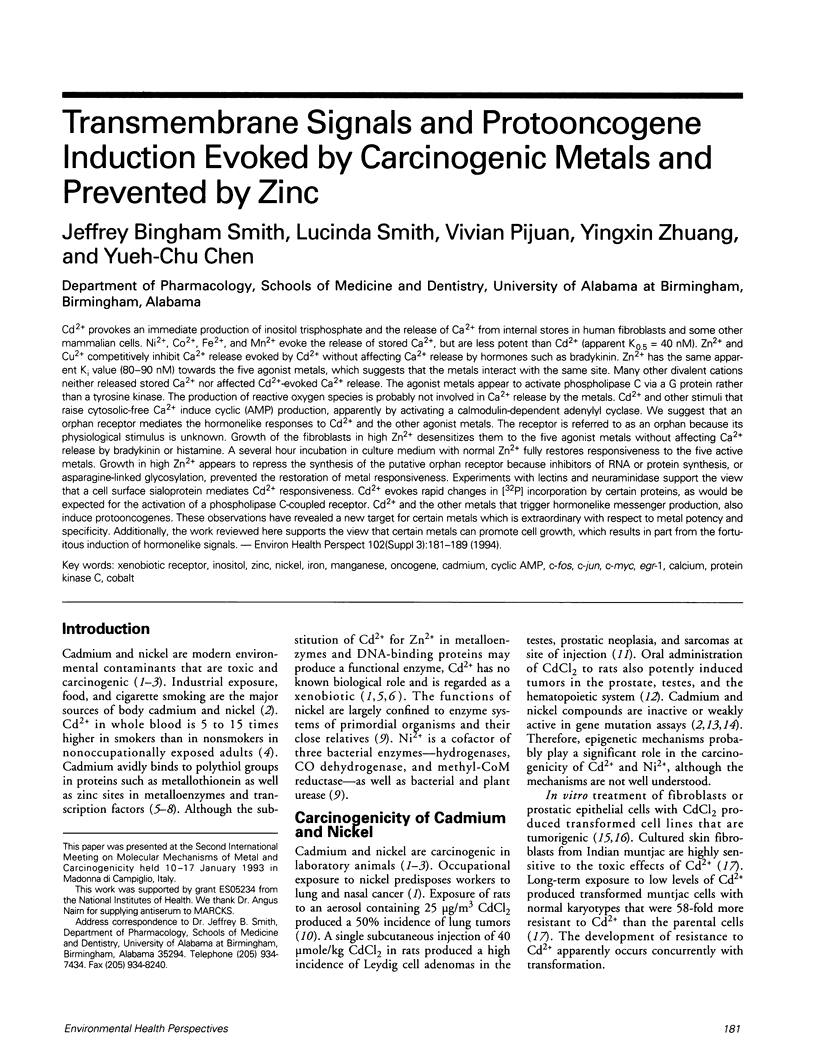
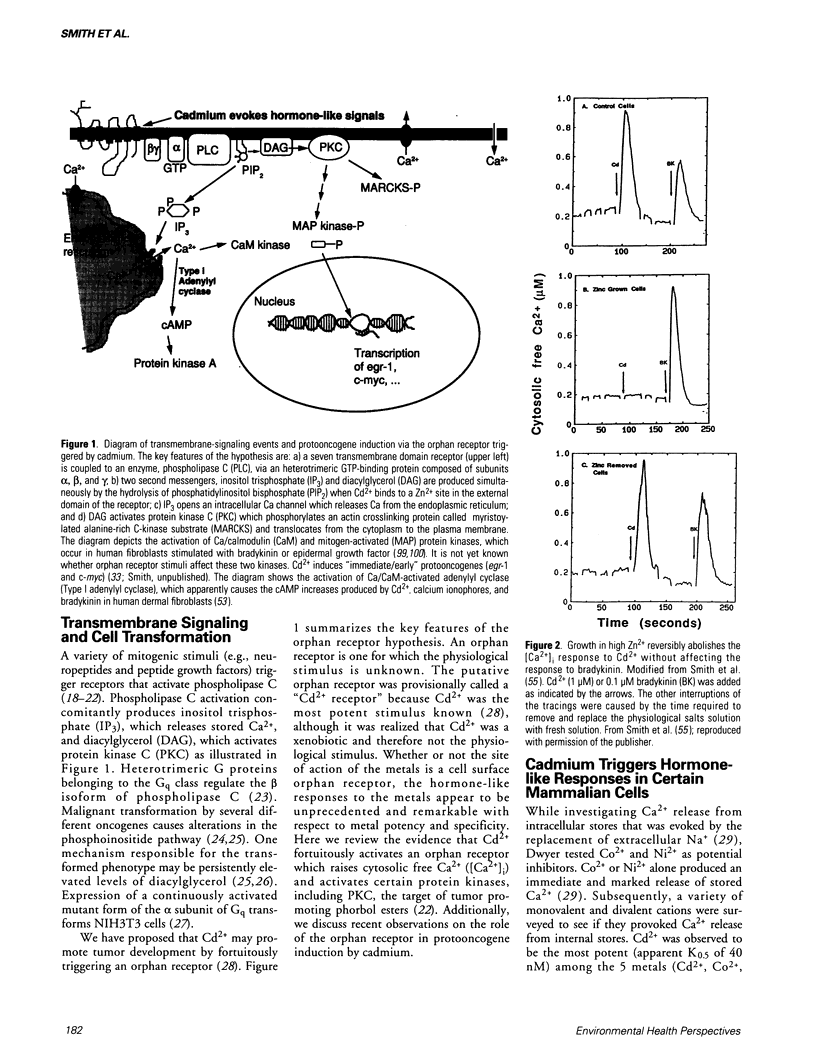
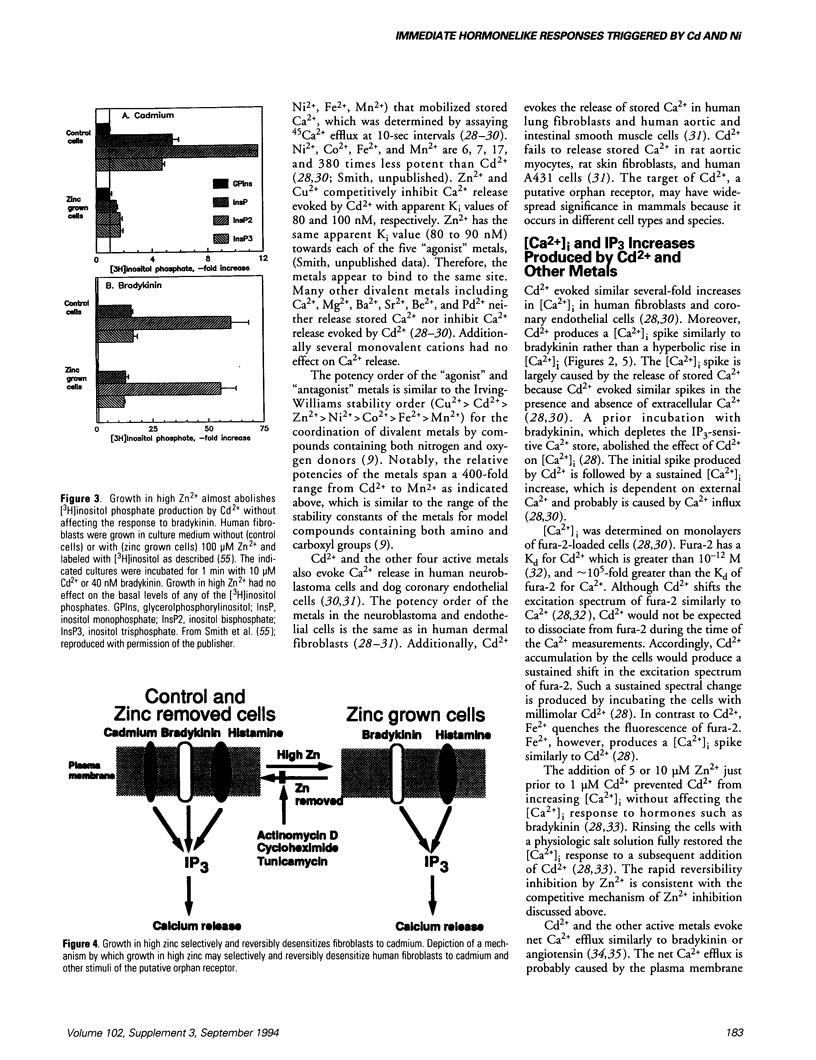
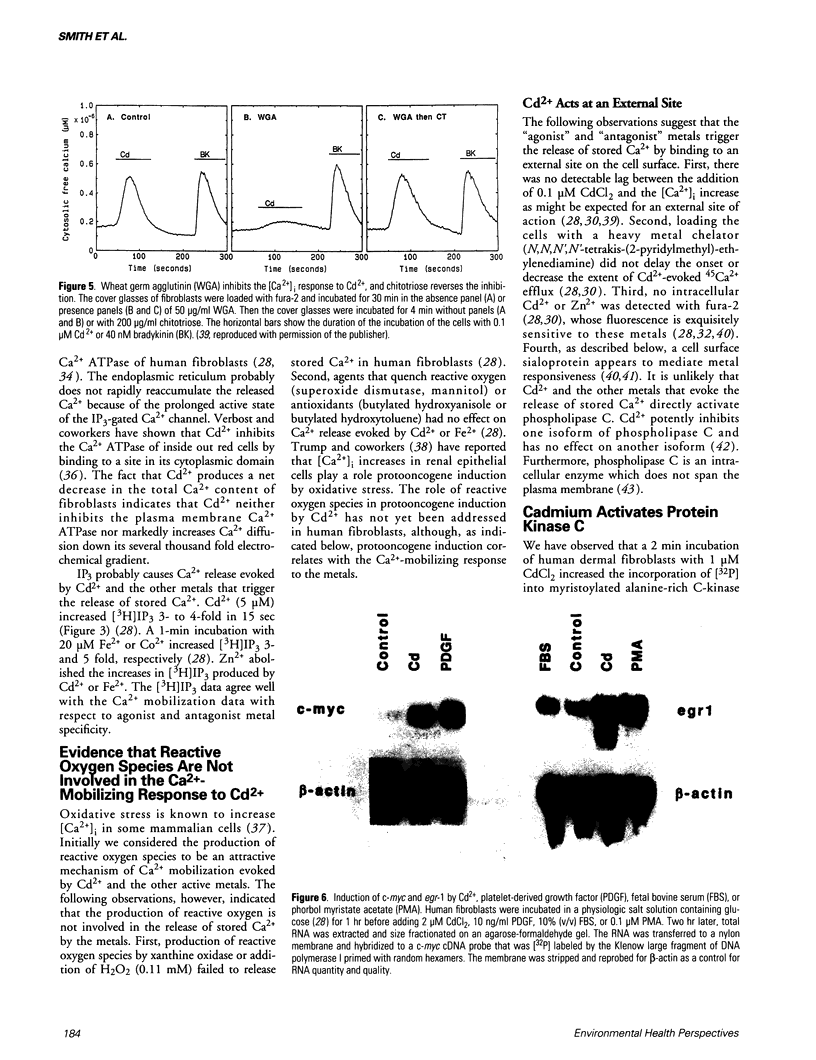
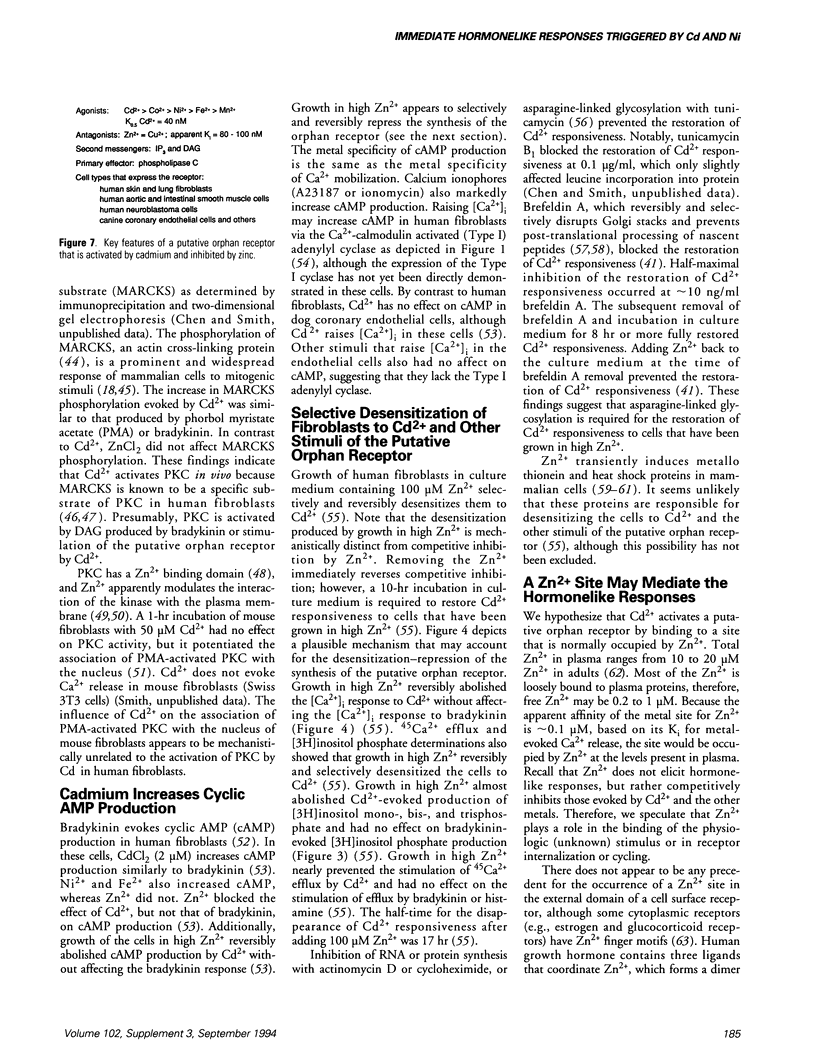
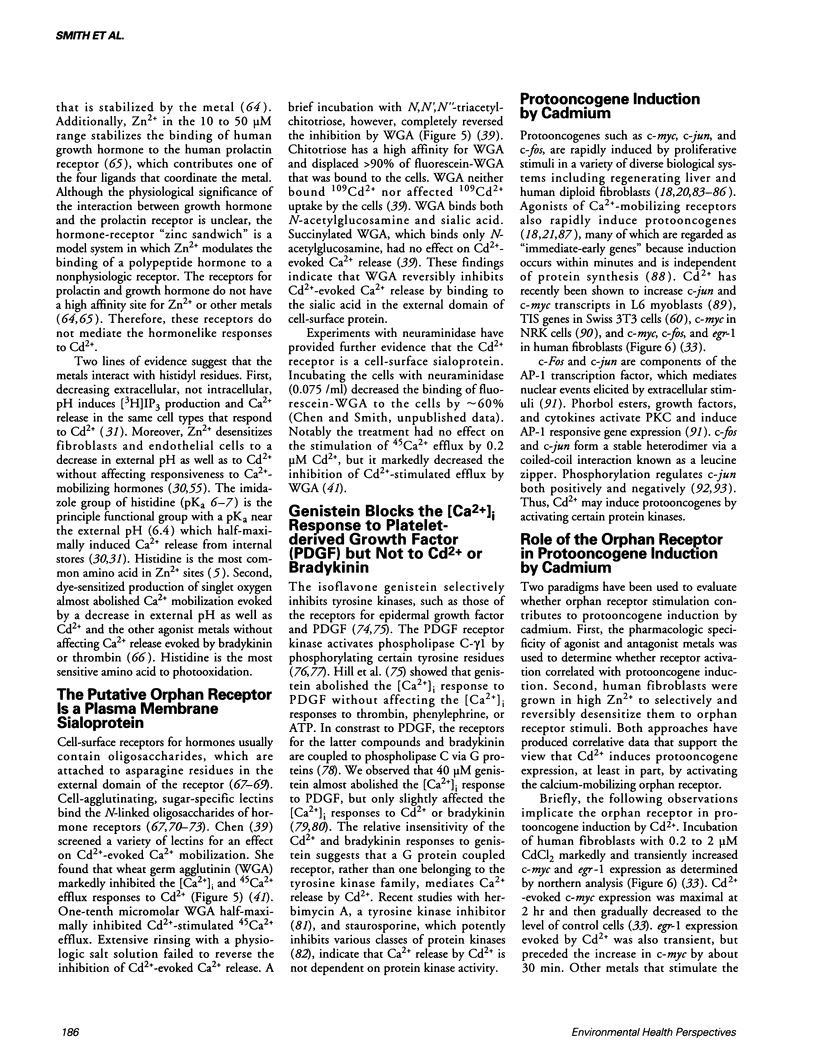
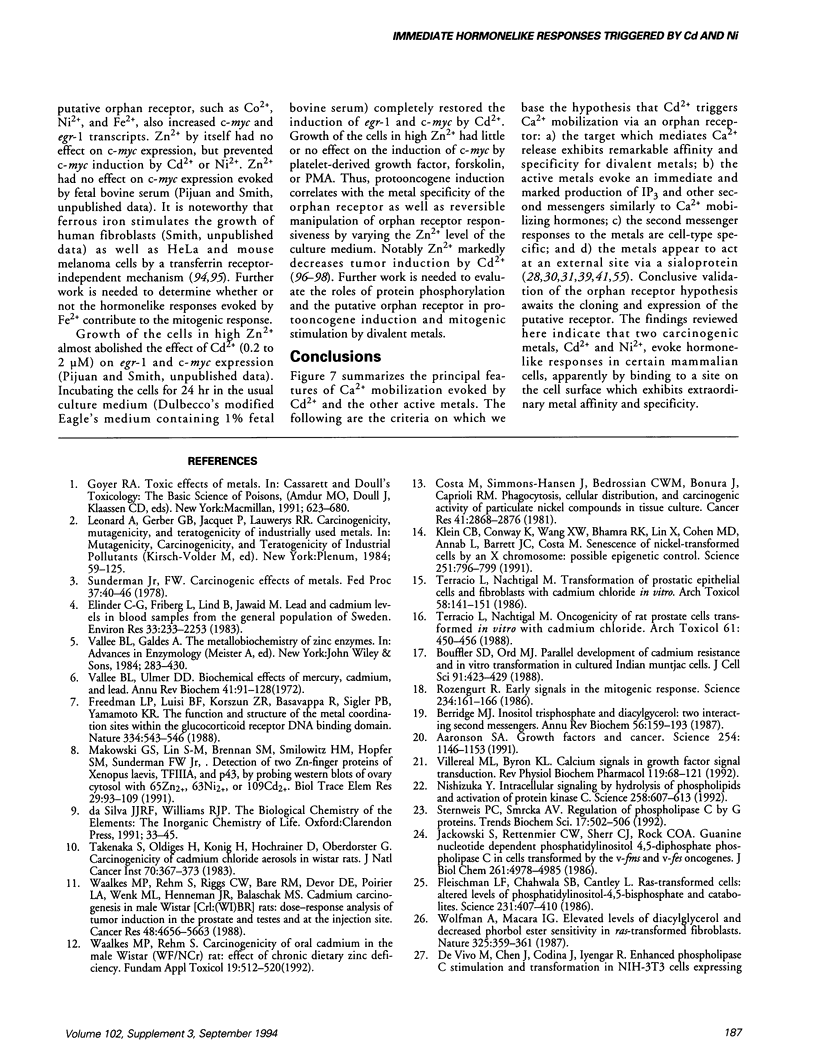
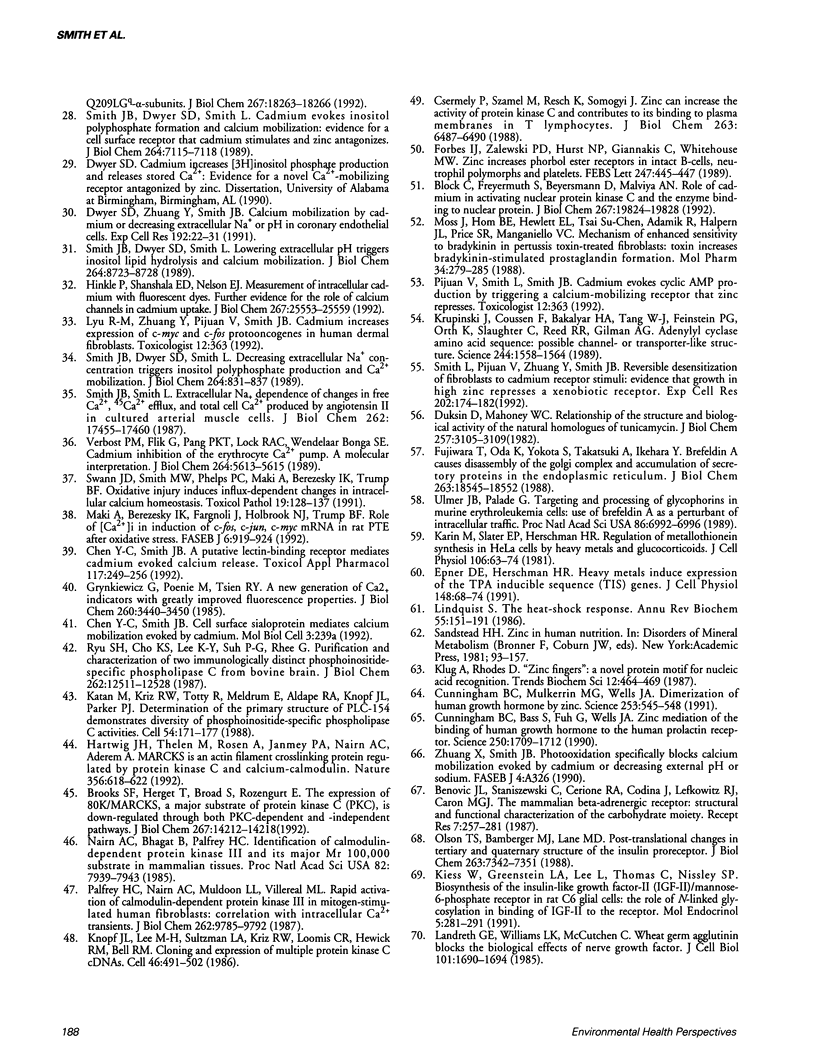
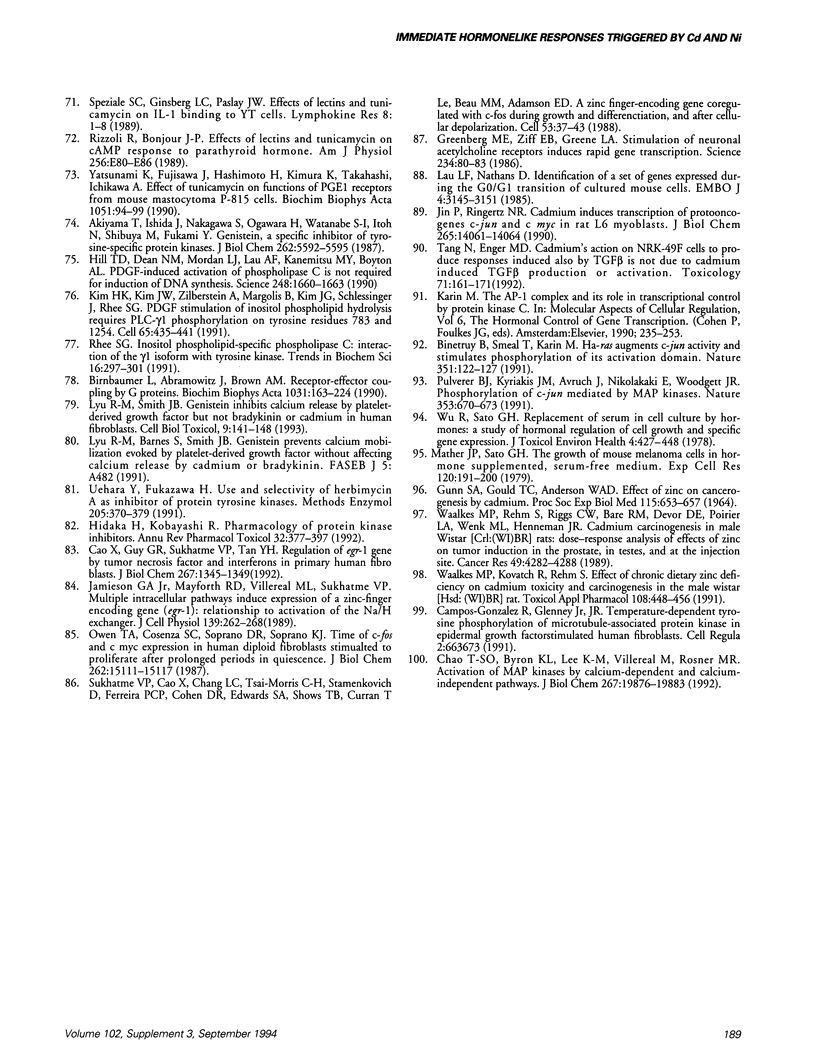
Images in this article
Selected References
These references are in PubMed. This may not be the complete list of references from this article.
- Aaronson S. A. Growth factors and cancer. Science. 1991 Nov 22;254(5035):1146–1153. doi: 10.1126/science.1659742. [DOI] [PubMed] [Google Scholar]
- Akiyama T., Ishida J., Nakagawa S., Ogawara H., Watanabe S., Itoh N., Shibuya M., Fukami Y. Genistein, a specific inhibitor of tyrosine-specific protein kinases. J Biol Chem. 1987 Apr 25;262(12):5592–5595. [PubMed] [Google Scholar]
- Benovic J. L., Staniszewski C., Cerione R. A., Codina J., Lefkowitz R. J., Caron M. G. The mammalian beta-adrenergic receptor: structural and functional characterization of the carbohydrate moiety. J Recept Res. 1987;7(1-4):257–281. doi: 10.3109/10799898709054989. [DOI] [PubMed] [Google Scholar]
- Berridge M. J. Inositol trisphosphate and diacylglycerol: two interacting second messengers. Annu Rev Biochem. 1987;56:159–193. doi: 10.1146/annurev.bi.56.070187.001111. [DOI] [PubMed] [Google Scholar]
- Binétruy B., Smeal T., Karin M. Ha-Ras augments c-Jun activity and stimulates phosphorylation of its activation domain. Nature. 1991 May 9;351(6322):122–127. doi: 10.1038/351122a0. [DOI] [PubMed] [Google Scholar]
- Birnbaumer L., Abramowitz J., Brown A. M. Receptor-effector coupling by G proteins. Biochim Biophys Acta. 1990 May 7;1031(2):163–224. doi: 10.1016/0304-4157(90)90007-y. [DOI] [PubMed] [Google Scholar]
- Block C., Freyermuth S., Beyersmann D., Malviya A. N. Role of cadmium in activating nuclear protein kinase C and the enzyme binding to nuclear protein. J Biol Chem. 1992 Oct 5;267(28):19824–19828. [PubMed] [Google Scholar]
- Bouffler S. D., Ord M. J. Parallel development of cadmium resistance and in vitro transformation in cultured Indian muntjac cells. J Cell Sci. 1988 Nov;91(Pt 3):423–429. doi: 10.1242/jcs.91.3.423. [DOI] [PubMed] [Google Scholar]
- Brooks S. F., Herget T., Broad S., Rozengurt E. The expression of 80K/MARCKS, a major substrate of protein kinase C (PKC), is down-regulated through both PKC-dependent and -independent pathways. Effects of bombesin, platelet-derived growth factor, and cAMP. J Biol Chem. 1992 Jul 15;267(20):14212–14218. [PubMed] [Google Scholar]
- Cao X. M., Guy G. R., Sukhatme V. P., Tan Y. H. Regulation of the Egr-1 gene by tumor necrosis factor and interferons in primary human fibroblasts. J Biol Chem. 1992 Jan 15;267(2):1345–1349. [PubMed] [Google Scholar]
- Chao T. S., Byron K. L., Lee K. M., Villereal M., Rosner M. R. Activation of MAP kinases by calcium-dependent and calcium-independent pathways. Stimulation by thapsigargin and epidermal growth factor. J Biol Chem. 1992 Oct 5;267(28):19876–19883. [PubMed] [Google Scholar]
- Chen Y. C., Smith J. B. A putative lectin-binding receptor mediates cadmium-evoked calcium release. Toxicol Appl Pharmacol. 1992 Dec;117(2):249–256. doi: 10.1016/0041-008x(92)90244-m. [DOI] [PubMed] [Google Scholar]
- Costa M., Simmons-Hansen J., Bedrossian C. W., Bonura J., Caprioli R. M. Phagocytosis, cellular distribution, and carcinogenic activity of particulate nickel compounds in tissue culture. Cancer Res. 1981 Jul;41(7):2868–2876. [PubMed] [Google Scholar]
- Csermely P., Szamel M., Resch K., Somogyi J. Zinc can increase the activity of protein kinase C and contributes to its binding to plasma membranes in T lymphocytes. J Biol Chem. 1988 May 15;263(14):6487–6490. [PubMed] [Google Scholar]
- Cunningham B. C., Bass S., Fuh G., Wells J. A. Zinc mediation of the binding of human growth hormone to the human prolactin receptor. Science. 1990 Dec 21;250(4988):1709–1712. doi: 10.1126/science.2270485. [DOI] [PubMed] [Google Scholar]
- Cunningham B. C., Mulkerrin M. G., Wells J. A. Dimerization of human growth hormone by zinc. Science. 1991 Aug 2;253(5019):545–548. doi: 10.1126/science.1907025. [DOI] [PubMed] [Google Scholar]
- Duksin D., Mahoney W. C. Relationship of the structure and biological activity of the natural homologues of tunicamycin. J Biol Chem. 1982 Mar 25;257(6):3105–3109. [PubMed] [Google Scholar]
- Dwyer S. D., Zhuang Y., Smith J. B. Calcium mobilization by cadmium or decreasing extracellular Na+ or pH in coronary endothelial cells. Exp Cell Res. 1991 Jan;192(1):22–31. doi: 10.1016/0014-4827(91)90152-k. [DOI] [PubMed] [Google Scholar]
- Elinder C. G., Friberg L., Lind B., Jawaid M. Lead and cadmium levels in blood samples from the general population of Sweden. Environ Res. 1983 Feb;30(1):233–253. doi: 10.1016/0013-9351(83)90183-4. [DOI] [PubMed] [Google Scholar]
- Epner D. E., Herschman H. R. Heavy metals induce expression of the TPA-inducible sequence (TIS) genes. J Cell Physiol. 1991 Jul;148(1):68–74. doi: 10.1002/jcp.1041480109. [DOI] [PubMed] [Google Scholar]
- Fleischman L. F., Chahwala S. B., Cantley L. ras-transformed cells: altered levels of phosphatidylinositol-4,5-bisphosphate and catabolites. Science. 1986 Jan 24;231(4736):407–410. doi: 10.1126/science.3001936. [DOI] [PubMed] [Google Scholar]
- Forbes I. J., Zalewski P. D., Hurst N. P., Giannakis C., Whitehouse M. W. Zinc increases phorbol ester receptors in intact B-cells, neutrophil polymorphs and platelets. FEBS Lett. 1989 Apr 24;247(2):445–447. doi: 10.1016/0014-5793(89)81388-2. [DOI] [PubMed] [Google Scholar]
- Freedman L. P., Luisi B. F., Korszun Z. R., Basavappa R., Sigler P. B., Yamamoto K. R. The function and structure of the metal coordination sites within the glucocorticoid receptor DNA binding domain. Nature. 1988 Aug 11;334(6182):543–546. doi: 10.1038/334543a0. [DOI] [PubMed] [Google Scholar]
- Fujiwara T., Oda K., Yokota S., Takatsuki A., Ikehara Y. Brefeldin A causes disassembly of the Golgi complex and accumulation of secretory proteins in the endoplasmic reticulum. J Biol Chem. 1988 Dec 5;263(34):18545–18552. [PubMed] [Google Scholar]
- GUNN S. A., GOULD T. C., ANDERSON W. A. EFFECT OF ZINC ON CANCEROGENESIS BY CADMIUM. Proc Soc Exp Biol Med. 1964 Mar;115:653–657. doi: 10.3181/00379727-115-28996. [DOI] [PubMed] [Google Scholar]
- Greenberg M. E., Ziff E. B., Greene L. A. Stimulation of neuronal acetylcholine receptors induces rapid gene transcription. Science. 1986 Oct 3;234(4772):80–83. doi: 10.1126/science.3749894. [DOI] [PubMed] [Google Scholar]
- Grynkiewicz G., Poenie M., Tsien R. Y. A new generation of Ca2+ indicators with greatly improved fluorescence properties. J Biol Chem. 1985 Mar 25;260(6):3440–3450. [PubMed] [Google Scholar]
- Hartwig J. H., Thelen M., Rosen A., Janmey P. A., Nairn A. C., Aderem A. MARCKS is an actin filament crosslinking protein regulated by protein kinase C and calcium-calmodulin. Nature. 1992 Apr 16;356(6370):618–622. doi: 10.1038/356618a0. [DOI] [PubMed] [Google Scholar]
- Hidaka H., Kobayashi R. Pharmacology of protein kinase inhibitors. Annu Rev Pharmacol Toxicol. 1992;32:377–397. doi: 10.1146/annurev.pa.32.040192.002113. [DOI] [PubMed] [Google Scholar]
- Hill T. D., Dean N. M., Mordan L. J., Lau A. F., Kanemitsu M. Y., Boynton A. L. PDGF-induced activation of phospholipase C is not required for induction of DNA synthesis. Science. 1990 Jun 29;248(4963):1660–1663. doi: 10.1126/science.2163545. [DOI] [PubMed] [Google Scholar]
- Hinkle P. M., Shanshala E. D., 2nd, Nelson E. J. Measurement of intracellular cadmium with fluorescent dyes. Further evidence for the role of calcium channels in cadmium uptake. J Biol Chem. 1992 Dec 15;267(35):25553–25559. [PubMed] [Google Scholar]
- Jackowski S., Rettenmier C. W., Sherr C. J., Rock C. O. A guanine nucleotide-dependent phosphatidylinositol 4,5-diphosphate phospholipase C in cells transformed by the v-fms and v-fes oncogenes. J Biol Chem. 1986 Apr 15;261(11):4978–4985. [PubMed] [Google Scholar]
- Jamieson G. A., Jr, Mayforth R. D., Villereal M. L., Sukhatme V. P. Multiple intracellular pathways induce expression of a zinc-finger encoding gene (EGR1): relationship to activation of the Na/H exchanger. J Cell Physiol. 1989 May;139(2):262–268. doi: 10.1002/jcp.1041390207. [DOI] [PubMed] [Google Scholar]
- Jin P., Ringertz N. R. Cadmium induces transcription of proto-oncogenes c-jun and c-myc in rat L6 myoblasts. J Biol Chem. 1990 Aug 25;265(24):14061–14064. [PubMed] [Google Scholar]
- Karin M., Slater E. P., Herschman H. R. Regulation of metallothionein synthesis in HeLa cells by heavy metals and glucocorticoids. J Cell Physiol. 1981 Jan;106(1):63–74. doi: 10.1002/jcp.1041060108. [DOI] [PubMed] [Google Scholar]
- Katan M., Kriz R. W., Totty N., Philp R., Meldrum E., Aldape R. A., Knopf J. L., Parker P. J. Determination of the primary structure of PLC-154 demonstrates diversity of phosphoinositide-specific phospholipase C activities. Cell. 1988 Jul 15;54(2):171–177. doi: 10.1016/0092-8674(88)90549-1. [DOI] [PubMed] [Google Scholar]
- Kiess W., Greenstein L. A., Lee L., Thomas C., Nissley S. P. Biosynthesis of the insulin-like growth factor-II (IGF-II)/mannose-6-phosphate receptor in rat C6 glial cells: the role of N-linked glycosylation in binding of IGF-II to the receptor. Mol Endocrinol. 1991 Feb;5(2):281–291. doi: 10.1210/mend-5-2-281. [DOI] [PubMed] [Google Scholar]
- Kim H. K., Kim J. W., Zilberstein A., Margolis B., Kim J. G., Schlessinger J., Rhee S. G. PDGF stimulation of inositol phospholipid hydrolysis requires PLC-gamma 1 phosphorylation on tyrosine residues 783 and 1254. Cell. 1991 May 3;65(3):435–441. doi: 10.1016/0092-8674(91)90461-7. [DOI] [PubMed] [Google Scholar]
- Klein C. B., Conway K., Wang X. W., Bhamra R. K., Lin X. H., Cohen M. D., Annab L., Barrett J. C., Costa M. Senescence of nickel-transformed cells by an X chromosome: possible epigenetic control. Science. 1991 Feb 15;251(4995):796–799. doi: 10.1126/science.1990442. [DOI] [PubMed] [Google Scholar]
- Knopf J. L., Lee M. H., Sultzman L. A., Kriz R. W., Loomis C. R., Hewick R. M., Bell R. M. Cloning and expression of multiple protein kinase C cDNAs. Cell. 1986 Aug 15;46(4):491–502. doi: 10.1016/0092-8674(86)90874-3. [DOI] [PubMed] [Google Scholar]
- Krupinski J., Coussen F., Bakalyar H. A., Tang W. J., Feinstein P. G., Orth K., Slaughter C., Reed R. R., Gilman A. G. Adenylyl cyclase amino acid sequence: possible channel- or transporter-like structure. Science. 1989 Jun 30;244(4912):1558–1564. doi: 10.1126/science.2472670. [DOI] [PubMed] [Google Scholar]
- Landreth G. E., Williams L. K., McCutchen C. Wheat germ agglutinin blocks the biological effects of nerve growth factor. J Cell Biol. 1985 Nov;101(5 Pt 1):1690–1694. doi: 10.1083/jcb.101.5.1690. [DOI] [PMC free article] [PubMed] [Google Scholar]
- Lau L. F., Nathans D. Identification of a set of genes expressed during the G0/G1 transition of cultured mouse cells. EMBO J. 1985 Dec 1;4(12):3145–3151. doi: 10.1002/j.1460-2075.1985.tb04057.x. [DOI] [PMC free article] [PubMed] [Google Scholar]
- Lyu R. M., Smith J. B. Genistein inhibits calcium release by platelet-derived growth factor but not bradykinin or cadmium in human fibroblasts. Cell Biol Toxicol. 1993 Apr-Jun;9(2):141–148. doi: 10.1007/BF00757576. [DOI] [PubMed] [Google Scholar]
- Maki A., Berezesky I. K., Fargnoli J., Holbrook N. J., Trump B. F. Role of [Ca2+]i in induction of c-fos, c-jun, and c-myc mRNA in rat PTE after oxidative stress. FASEB J. 1992 Feb 1;6(3):919–924. doi: 10.1096/fasebj.6.3.1740241. [DOI] [PubMed] [Google Scholar]
- Makowski G. S., Lin S. M., Brennan S. M., Smilowitz H. M., Hopfer S. M., Sunderman F. W., Jr Detection of two Zn-finger proteins of Xenopus laevis, TFIIIA, and p43, by probing western blots of ovary cytosol with 65Zn2+, 63Ni2+, or 109Cd2+. Biol Trace Elem Res. 1991 May;29(2):93–109. doi: 10.1007/BF03032687. [DOI] [PubMed] [Google Scholar]
- Mather J. P., Sato G. H. The growth of mouse melanoma cells in hormone-supplemented, serum-free medium. Exp Cell Res. 1979 Apr;120(1):191–200. doi: 10.1016/0014-4827(79)90549-4. [DOI] [PubMed] [Google Scholar]
- Moss J., Hom B. E., Hewlett E. L., Tsai S. C., Adamik R., Halpern J. L., Price S. R., Manganiello V. C. Mechanism of enhanced sensitivity to bradykinin in pertussis toxin-treated fibroblasts: toxin increases bradykinin-stimulated prostaglandin formation. Mol Pharmacol. 1988 Sep;34(3):279–285. [PubMed] [Google Scholar]
- Nairn A. C., Bhagat B., Palfrey H. C. Identification of calmodulin-dependent protein kinase III and its major Mr 100,000 substrate in mammalian tissues. Proc Natl Acad Sci U S A. 1985 Dec;82(23):7939–7943. doi: 10.1073/pnas.82.23.7939. [DOI] [PMC free article] [PubMed] [Google Scholar]
- Nishizuka Y. Intracellular signaling by hydrolysis of phospholipids and activation of protein kinase C. Science. 1992 Oct 23;258(5082):607–614. doi: 10.1126/science.1411571. [DOI] [PubMed] [Google Scholar]
- Olson T. S., Bamberger M. J., Lane M. D. Post-translational changes in tertiary and quaternary structure of the insulin proreceptor. Correlation with acquisition of function. J Biol Chem. 1988 May 25;263(15):7342–7351. [PubMed] [Google Scholar]
- Owen T. A., Cosenza S. C., Soprano D. R., Soprano K. J. Time of c-fos and c-myc expression in human diploid fibroblasts stimulated to proliferate after prolonged periods in quiescence. J Biol Chem. 1987 Nov 5;262(31):15111–15117. [PubMed] [Google Scholar]
- Palfrey H. C., Nairn A. C., Muldoon L. L., Villereal M. L. Rapid activation of calmodulin-dependent protein kinase III in mitogen-stimulated human fibroblasts. Correlation with intracellular Ca2+ transients. J Biol Chem. 1987 Jul 15;262(20):9785–9792. [PubMed] [Google Scholar]
- Pulverer B. J., Kyriakis J. M., Avruch J., Nikolakaki E., Woodgett J. R. Phosphorylation of c-jun mediated by MAP kinases. Nature. 1991 Oct 17;353(6345):670–674. doi: 10.1038/353670a0. [DOI] [PubMed] [Google Scholar]
- Rhee S. G. Inositol phospholipids-specific phospholipase C: interaction of the gamma 1 isoform with tyrosine kinase. Trends Biochem Sci. 1991 Aug;16(8):297–301. doi: 10.1016/0968-0004(91)90122-c. [DOI] [PubMed] [Google Scholar]
- Rizzoli R., Bonjour J. P. Effects of lectins and tunicamycin on cAMP response to parathyroid hormone. Am J Physiol. 1989 Jan;256(1 Pt 1):E80–E86. doi: 10.1152/ajpendo.1989.256.1.E80. [DOI] [PubMed] [Google Scholar]
- Rozengurt E. Early signals in the mitogenic response. Science. 1986 Oct 10;234(4773):161–166. doi: 10.1126/science.3018928. [DOI] [PubMed] [Google Scholar]
- Ryu S. H., Cho K. S., Lee K. Y., Suh P. G., Rhee S. G. Purification and characterization of two immunologically distinct phosphoinositide-specific phospholipases C from bovine brain. J Biol Chem. 1987 Sep 15;262(26):12511–12518. [PubMed] [Google Scholar]
- Smith J. B., Dwyer S. D., Smith L. Cadmium evokes inositol polyphosphate formation and calcium mobilization. Evidence for a cell surface receptor that cadmium stimulates and zinc antagonizes. J Biol Chem. 1989 May 5;264(13):7115–7118. [PubMed] [Google Scholar]
- Smith J. B., Dwyer S. D., Smith L. Decreasing extracellular Na+ concentration triggers inositol polyphosphate production and Ca2+ mobilization. J Biol Chem. 1989 Jan 15;264(2):831–837. [PubMed] [Google Scholar]
- Smith J. B., Dwyer S. D., Smith L. Lowering extracellular pH evokes inositol polyphosphate formation and calcium mobilization. J Biol Chem. 1989 May 25;264(15):8723–8728. [PubMed] [Google Scholar]
- Smith J. B., Smith L. Extracellular Na+ dependence of changes in free Ca2+, 45Ca2+ efflux, and total cell Ca2+ produced by angiotensin II in cultured arterial muscle cells. J Biol Chem. 1987 Dec 25;262(36):17455–17460. [PubMed] [Google Scholar]
- Smith L., Pijuan V., Zhuang Y., Smith J. B. Reversible desensitization of fibroblasts to cadmium receptor stimuli: evidence that growth in high zinc represses a xenobiotic receptor. Exp Cell Res. 1992 Sep;202(1):174–182. doi: 10.1016/0014-4827(92)90417-7. [DOI] [PubMed] [Google Scholar]
- Speziale S. C., Ginsberg L. C., Paslay J. W. Effects of lectins and tunicamycin on IL-1 binding to YT cells. Lymphokine Res. 1989 Spring;8(1):1–8. [PubMed] [Google Scholar]
- Sternweis P. C., Smrcka A. V. Regulation of phospholipase C by G proteins. Trends Biochem Sci. 1992 Dec;17(12):502–506. doi: 10.1016/0968-0004(92)90340-f. [DOI] [PubMed] [Google Scholar]
- Sukhatme V. P., Cao X. M., Chang L. C., Tsai-Morris C. H., Stamenkovich D., Ferreira P. C., Cohen D. R., Edwards S. A., Shows T. B., Curran T. A zinc finger-encoding gene coregulated with c-fos during growth and differentiation, and after cellular depolarization. Cell. 1988 Apr 8;53(1):37–43. doi: 10.1016/0092-8674(88)90485-0. [DOI] [PubMed] [Google Scholar]
- Sunderman F. W., Jr Carcinogenic effects of metals. Fed Proc. 1978 Jan;37(1):40–46. [PubMed] [Google Scholar]
- Swann J. D., Smith M. W., Phelps P. C., Maki A., Berezesky I. K., Trump B. F. Oxidative injury induces influx-dependent changes in intracellular calcium homeostasis. Toxicol Pathol. 1991;19(2):128–137. doi: 10.1177/019262339101900207. [DOI] [PubMed] [Google Scholar]
- Takenaka S., Oldiges H., König H., Hochrainer D., Oberdörster G. Carcinogenicity of cadmium chloride aerosols in W rats. J Natl Cancer Inst. 1983 Feb;70(2):367–373. [PubMed] [Google Scholar]
- Tang N., Enger M. D. Cadmium's action on NRK-49F cells to produce responses induced also by TGF beta is not due to cadmium induced TGF beta production or activation. Toxicology. 1992;71(1-2):161–171. doi: 10.1016/0300-483x(92)90063-k. [DOI] [PubMed] [Google Scholar]
- Terracio L., Nachtigal M. Oncogenicity of rat prostate cells transformed in vitro with cadmium chloride. Arch Toxicol. 1988;61(6):450–456. doi: 10.1007/BF00293691. [DOI] [PubMed] [Google Scholar]
- Terracio L., Nachtigal M. Transformation of prostatic epithelial cells and fibroblasts with cadmium chloride in vitro. Arch Toxicol. 1986 Feb;58(3):141–151. doi: 10.1007/BF00340973. [DOI] [PubMed] [Google Scholar]
- Uehara Y., Fukazawa H. Use and selectivity of herbimycin A as inhibitor of protein-tyrosine kinases. Methods Enzymol. 1991;201:370–379. doi: 10.1016/0076-6879(91)01033-x. [DOI] [PubMed] [Google Scholar]
- Ulmer J. B., Palade G. E. Targeting and processing of glycophorins in murine erythroleukemia cells: use of brefeldin A as a perturbant of intracellular traffic. Proc Natl Acad Sci U S A. 1989 Sep;86(18):6992–6996. doi: 10.1073/pnas.86.18.6992. [DOI] [PMC free article] [PubMed] [Google Scholar]
- Vallee B. L., Ulmer D. D. Biochemical effects of mercury, cadmium, and lead. Annu Rev Biochem. 1972;41(10):91–128. doi: 10.1146/annurev.bi.41.070172.000515. [DOI] [PubMed] [Google Scholar]
- Verbost P. M., Flik G., Pang P. K., Lock R. A., Wendelaar Bonga S. E. Cadmium inhibition of the erythrocyte Ca2+ pump. A molecular interpretation. J Biol Chem. 1989 Apr 5;264(10):5613–5615. [PubMed] [Google Scholar]
- Villereal M. L., Byron K. L. Calcium signals in growth factor signal transduction. Rev Physiol Biochem Pharmacol. 1992;119:67–121. doi: 10.1007/3540551921_4. [DOI] [PubMed] [Google Scholar]
- Waalkes M. P., Kovatch R., Rehm S. Effect of chronic dietary zinc deficiency on cadmium toxicity and carcinogenesis in the male Wistar [Hsd: (WI)BR] rat. Toxicol Appl Pharmacol. 1991 May;108(3):448–456. doi: 10.1016/0041-008x(91)90091-r. [DOI] [PubMed] [Google Scholar]
- Waalkes M. P., Rehm S. Carcinogenicity of oral cadmium in the male Wistar (WF/NCr) rat: effect of chronic dietary zinc deficiency. Fundam Appl Toxicol. 1992 Nov;19(4):512–520. doi: 10.1016/0272-0590(92)90089-z. [DOI] [PubMed] [Google Scholar]
- Waalkes M. P., Rehm S., Riggs C. W., Bare R. M., Devor D. E., Poirier L. A., Wenk M. L., Henneman J. R., Balaschak M. S. Cadmium carcinogenesis in male Wistar [Crl:(WI)BR] rats: dose-response analysis of tumor induction in the prostate and testes and at the injection site. Cancer Res. 1988 Aug 15;48(16):4656–4663. [PubMed] [Google Scholar]
- Waalkes M. P., Rehm S., Riggs C. W., Bare R. M., Devor D. E., Poirier L. A., Wenk M. L., Henneman J. R. Cadmium carcinogenesis in male Wistar [Crl:(WI)BR] rats: dose-response analysis of effects of zinc on tumor induction in the prostate, in the testes, and at the injection site. Cancer Res. 1989 Aug 1;49(15):4282–4288. [PubMed] [Google Scholar]
- Wolfman A., Macara I. G. Elevated levels of diacylglycerol and decreased phorbol ester sensitivity in ras-transformed fibroblasts. Nature. 1987 Jan 22;325(6102):359–361. doi: 10.1038/325359a0. [DOI] [PubMed] [Google Scholar]
- Wu R., Sato G. H. Replacement of serum in cell culture by hormones: a study of hormonal regulation of cell growth and specific gene expression. J Toxicol Environ Health. 1978 Mar-May;4(2-3):427–448. doi: 10.1080/15287397809529669. [DOI] [PubMed] [Google Scholar]
- Yatsunami K., Fujisawa J., Hashimoto H., Kimura K., Takahashi S., Ichikawa A. Effect of tunicamycin on functions of PGE1 receptors from mouse mastocytoma P-815 cells. Biochim Biophys Acta. 1990 Jan 23;1051(1):94–99. doi: 10.1016/0167-4889(90)90178-g. [DOI] [PubMed] [Google Scholar]



